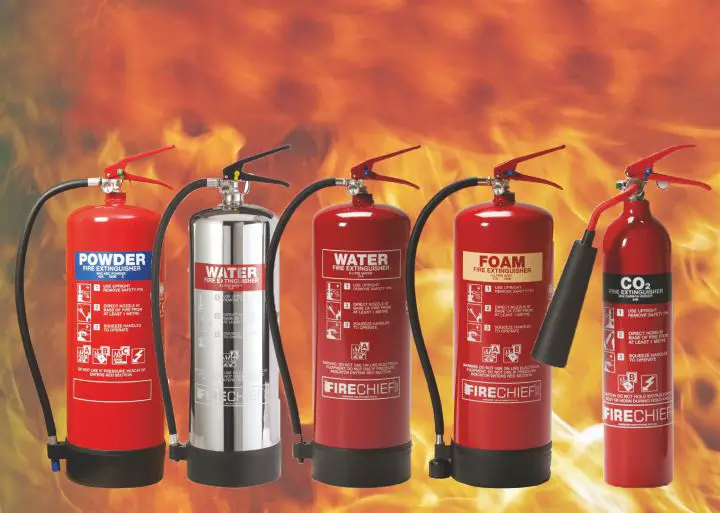We all know that our places are equipped with hand portable fire and extinguisher what we need to know is where they are placed and which extinguisher to choose for which class of fire.
And the most important thing that we all need to know is that not all the hand portable fire extinguishers can wipe out all the fires.
And for this very purpose, there are different types of hand-portable extinguishers to put out various types of fires.
And you should make sure to install the proper fire extinguisher installed in your vicinity so that you can deal with the fire emergency on time.
Fire Chemistry and Why Fire Class Matters?
There are five fundamental classes of fire that can cause potential fire emergencies and hazards.
Class A Fires
Class A contains inflammable solid materials such as wood, paper, textile, and plastic. It contains freely combustible materials.
Class B Fires
Class B contains combustible liquid materials such as petrol, diesel, gasoline, oils, and combustible gases. Class B fires are most commonly found in homes and business buildings.
Class C Fires
Class C of fire contains electrical fires. It involves a fire that wraps the electrical appliances. Class A and B fires which involve electrical short circuits or fires including electrical appliances in it are also categorized under the class C fires. And as soon as the electricity is not involved, the class of fire is no more C.
Class D Fires
Class D of fire includes metallic fires. It includes metals such as zirconium, sodium, magnesium, titanium, etc.
Class K Fires
Class K fires also known as cooking fires; include vegetable oils, animal fat, and oils. These fires are most commonly found in kitchens of homes and restaurants.
Although there are different types of fires, there are some similarities, which are found in almost all types of fires, and you need to consider them to wipe out fire emergencies in your home or building.
The four fundamental elements that are present in all fires are; oxygen, fuel, heat, and chain reaction. Though the fuel, heat, and chain reactions can be different for different fires, what remains constant is that fire needs oxygen to burn.
Now you will be able to identify each type of fire it’s time to get to know different types of hand-portable extinguishers.
Types of Fire Extinguishers
ABC Powder Fire Extinguisher
ABC powder fire extinguishers are multi-purpose portable hand extinguishers that can wipe out more than one class of fires as the name shows.
It is the most common type of hand extinguisher and is widely used in different settings such as home and office buildings.
Powder fire extinguisher contains mono ammonium phosphate in a very fine powder form. This fine powder is sprayed on the fire to wipe out the fire.
Mono ammonium phosphate is not an electrical conductor so; using it in the hand portable extinguisher can also put off class C fires.
Carbon Dioxide Fire Extinguisher
Carbon dioxide fire extinguishers are called the cleanest type of fire extinguishers because they leave no residue behind.
Carbon dioxide extinguishes fire by eliminating one of the main elements of causing fire yes, it wipes out the fire by removing the oxygen from the source.
It is best for fires that do not have electricity involvement and goes perfectly with class B fires where it extinguishes combustible liquids
Wet Chemical Fire Extinguisher
Wet chemical fire extinguishers are made for class K fires, where the hand portable extinguisher puts off fire caused by cooking media such as animal and vegetable fats and oils.
Wet chemical fire extinguishers are comprised of a potassium solution that works best with the class K fires and wipes them out of existence.
Firstly, the solution is sprayed on the fire, and it helps the fire flames to cool down. Secondly, the potassium solution forms a soap-like solution on the fire caused by the cooking oils.
This soap-like mechanism of the extinguishing solution not only works on putting out the fire, but it also blocks the oil particles eradicating all the possible chances of re-ignition of fire.
Wet chemical fire extinguishers are also used sometimes for the class A fires where they put out fires caused with the solid combustible materials like wood, textile, and paper.
Water Mist Fire Extinguisher
Water mist fire extinguishers are one of the most flexible hand portable fire extinguishers that work to extinguish more than one class of fire.
Water mist fire extinguishers work by spraying out microscopic particles of water on the flames of fire to cool them and decrease the temperature.
De-ionized water is used in the water mist fire extinguisher, which means that all the charged minerals are removed from the water, making the extinguisher even perfect for the class C fires.
Water mist fire extinguishers can be used for class A, B, C, and K fires and can effectively put out these classes of fire.






